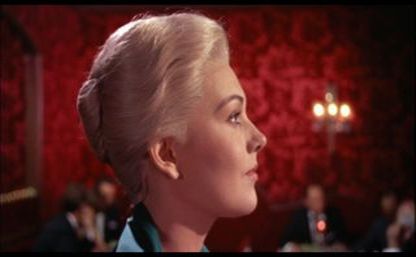The MacGuffin: News and Comment (01/Dec/2007)
(c) Ken Mogg (2007)
December 1
I suggested last time that the red walls of Ernie's Restaurant imply both life and death, harking back to the opening scene on a rooftop. Of course, the action of falling off a roof is an ambiguous act in itself - an image of death, obviously, but also, in terms of dream imagery, of birth. Scottie was already a 'failure' when, in one reading, he fell from the rooftop at the start of the film. (He had hoped to become Chief of Police but somehow significant promotion had eluded him.) Not surprisingly, then, the film has several moments of 're-birthing', all of them connected with Scottie's 'dream woman', Madeleine. The first is the very image we discussed last time, in which 'Madeleine' emerges from the dining room at Ernie's and pauses beside an image of a baby and a newly-blooming rose. Her emerald wrap - the colour of the ocean - is apt. Another image of 're-birthing' will occur when Scottie rescues 'Madeleine' from San Francisco Bay. Another will be when the made-over (by Scottie) Judy emerges, as Madeleine, from her bathroom at the Empire Hotel into the same emerald-green light, now redolent of mist and ghosts. So, coming back to Ernie's Restaurant, there's a sense that its red walls are womb-like. But Hitchcock is not finished. The sequence effectively began in long-shot as the camera panned from Scottie to discover 'Madeleine' dining with Gavin; it will climax with 'Madeleine' alone in close-up (see frame-capture below), then end on a dying fall as 'Madeleine' and Gavin exit past a full-length mirror that emphasises Scottie's sense of already losing this mysterious, beautiful woman. (The pay-off to this moment, and several echoes of it, will be Scottie's line later, 'I do have you now, don't I?') How artful this whole sequence is, and the close-up profile-shot of 'Madeleine' in particular! In Strangers on a Train (1951), in the initial funfair sequence, Hitchcock had employed a succession of small climaxes (e.g., a woman screaming in a river-cave) to ready the audience for the eventual big climax, the strangling of Miriam, seen reflected in a lens of her glasses that had been knocked to the ground. That sequence was essentially a suspense sequence. The climactic moment was lent additional impact by the exaggeration of the effect, by the sense that the inner meaning of the moment called for just this distortion from an everyday way-of-seeing. (Cf, say, the initial kiss in Rear Window, an effect achieved with a form of step-printing.) But the sequence in Vertigo is, rather, a more purely aesthetic one, though the technique has scarcely changed. The first climax had occurred when the camera in long-shot discovered the bare-backed 'Madeleine' dining with Gavin. The second occurs when 'Madeleine' pauses by the picture and the rose, and we can briefly savour her fine bosom and all of the beauty surrounding it - not least the rose which emblemises that beauty (as Madeleine herself emblemises beauty and 'life'). But the moment is fleeting. The final climax is our, and Scottie's, tantalising reward. In this glorious profile-shot 'Madeleine' is now seemingly only inches away from us, and her lips are poised, waiting. The music climaxes. Hitchcock daringly brings up the light on the red wall - a deliberate exaggeration that is perfectly right - and it is as if the rose we had just seen is now blooming at its very height. (What a pity second-unit director Herbert Coleman used the wrong lens for the supposedly matching shot that follows, after the cut-away to Scottie. There is a momentary jarring. I suspect that Hitchcock never fully forgave 'Herbie' for that!)
This material is copyright of Ken Mogg and the Hitchcock Scholars/'MacGuffin' website (home page) and is archived with the permission of the copyright holder. |

